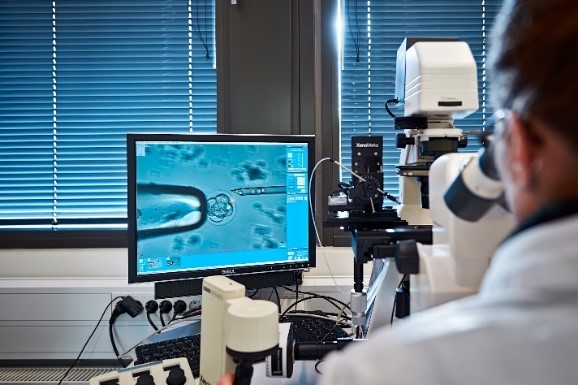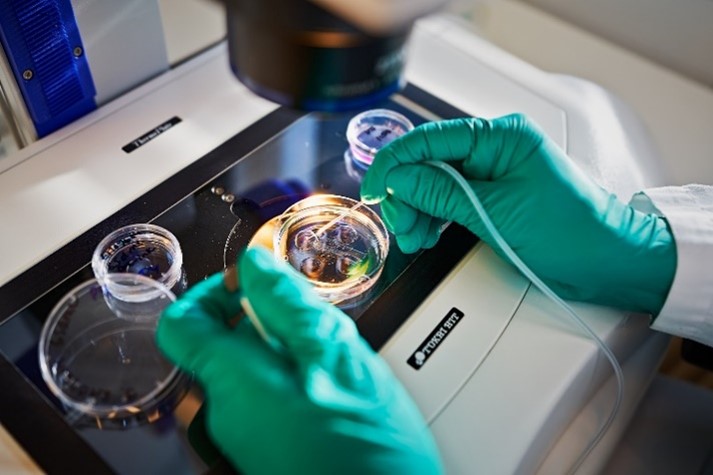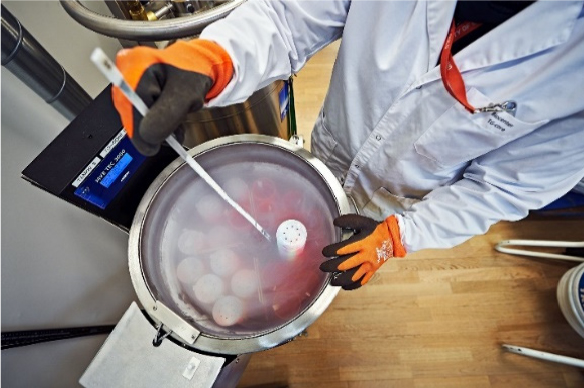GM mice remain important model organisms for understanding the molecular basis of health and disease in man and serve as suitable animal models for human disease. They, thus, have an important role in the development of new therapeutic approaches to human diseases. Working with GM mice requires specific ethical and legislative issues according to the 3Rs principles, and thus, well-trained personnel are of key importance.
Nodes
UEF: University of Eastern Finland; UH: University of Helsinki; UO: University of Oulu; UTU: University of Turku
Contact details
Platform Chair
Reetta Hinttala
reetta.hinttala@oulu.fi / +358-(0)294 486135
Biocenter Oulu, University of Oulu
Services
Biocenter Oulu Transgenic and Tissue Phenotyping Core Facility
CRISPR/CAS9 design and electroporation, DNA pronuclear injection, ES cell targeting and morula injection.
CRYOPRESERVATION
Mouse lines cryopreserved by sperm freezing or embryo freezing.
REDERIVATION
Recovery of a mouse line either via in vitro fertilization (IVF) with frozen sperm or transfer of frozen embryos.
Rederivation of contaminated mouse lines either via in vitro fertilization (IVF) or transfer of morula stage embryos.
INTERNATIONAL SHIPMENTS
Shipping and receiving cryopreserved GM strains.
GENERATION OF INDUCED PLURIPOTENT STEM (IPS) CELLS
Fibroblasts induced either by episomal reprogramming (human) or retroviral infection (mouse).
ISOLATION OF EMBRYONIC STEM (ES) CELLS
The 2i ES method to isolate and expand the ES cells from the requested mouse line.
HISTOPATHOLOGY SERVICES
Facilities and services for preparation, staining, and scanning of histology samples. Hamamatsu S60 is used for brightfield scanning of tissue slides. Visiopharm software and APP design is provided as a service for the machine learning-based image analysis of tissue properties.
GM unit of the Laboratory Animal Center at University of Helsinki
DNA pronuclear injection (mouse) and CRISPR/CAS9 (mouse and rat).
Embryonic stem cell culture
Morula aggregation
CRYOPRESERVATION
Embryo (mouse and rat) and sperm freezing (mouse).
REDERIVATION
Strain recovery from frozen embryos (mouse and rat) and sperm (mouse).
Pathogen removal (mouse and rat)
INTERNATIONAL SHIPMENTS
Shipping and receiving cryopreserved GM strains.
TCDM
Pronucleus injection, ES targeting, CRISPR-Cas9 mutations
GENERATION OF XENOGRAFT MOUSE MODELS
Xenografts and syngenic models, drug treatments
MOUSE LINE CRYOPRESERVATION
Embryos, sperm
REDERIVATION
Mouse strain recovery from frozen embryos or sperm
Pathogen removal
INTERNATIONAL SHIPMENTS
Shipping and receiving cryopreserved GM strains
PHARMACOLOGICAL, DIETARY AND SURGICAL INTERVENTIONS
MOUSE COLONY MANAGEMENT
CELL CULTURE
Mouse ES cells, human cancer cell lines, patient-derived cells
HISTOPATHOLOGY SERVICE
From tissue processing to image quantitation (in collaboration with Inst. of Biomedicine Histocore)
PHENOTYPING (COLLABORATION BASED)
- Animal imaging: PET/CT, magnetic resonance, ultrasound and optical imaging
- Bone biology: X-ray analyses, bone histomorphometry, mineral content, tension strength
- Cardiovascular research: In vitro assessment of cardiac and vascular functions by isometric micromyography, Langendorf perfused heart preparation and Radnoti working heart model
- Clinical chemistry: Sensitive immunoflurometric assayas (Delfia), Elisa kits, Multiplex immunoassays
- Intestinal diseases: Colitis (colonic inflammation, inflammatory bowel diseases) and colon cancer analyses
- Neuroendocrinology: Quantitative and in situ expression analyses of neuropeptides and receptors at the gene and protein levels in specific brain regions, analysis of hormonal and gene/protein expression in hypothalamus and pituitary
- Nutrition and Metabolism: Various dietary interventions, food intake and feeding behavior, energy expenditure, physical activity, body composition, adipose tissue morphology and function, body temperature, glucose and lipid metabolism, hepatosteatosis
- Reproduction: analyses of reproductive performance, in vitro fertilization (IVF), sperm morphological, functional (capacitation, acrosome reaction) and motility (CASA) analyses
- Tumor Biology: Generation of xenograft models, genetically modified mouse tumor models and chemically induced cancer models, tumor growth follow-up (palpations, optical imaging), treatment trials
- Urodynamics: Bladder pressure recordings, urine flow rates, measurements of electrical activities of the urethral striated muscle
Finnish Centre for Laboratory Animal Pathology
Trimming, processing and paraffin embedding of tissue specimens for histology
Preparation of unstained and stained sections (HE and a range of special stains)
Immunohistochemistry (markers used in diagnostic veterinary pathology)
Preparation of frozen sections, subsequent staining and IH
Consultation and tutoring on histological tissue processing
PATHOLOGY
Assessment of morphological changes from a wide range of experiments and in the development of new experimental protocols
Necropsy and tissue/sample collection
Assistance with experimental design and morphological techniques
RESEARCH COOPERATION
Involvement of pathologists in interdisciplinary research; experimental approach and protocols, histological assessment, interpretation, further studies etc.
Mouse Behavioral Phenotyping Facility (MBPF)
FULL SERVICE
All testing performed and analyzed by MBPF staff. At the end of the study, MBPF will provide all raw data, analyzed results, and necessary documents as a final project report and present the result at a final project meeting if desired.
TRAINING SERVICE
All testing performed by staff from your group after training by MBPF staff. Analysis of the data can be performed either by your or MBPF staff. At the end of the study, MBPF will provide all raw data and necessary documents.
MINIMUM SERVICE
All testing performed and analyzed by staff from your own group after introduction. At the end of the study, MBPF will provide all raw data and necessary documents as a raw project report.
LIST OF AVAILABLE TESTS
- Circadian activity – single housed animals (InfraMot), group-housed animals (IntelliCage)
- Automated home-cage – behavior and cognitive performance in automated, social home cage without experimenter interference (IntelliCage)
- Emotional behavior – elevated plus-maze, elevated zero-maze, novelty-suppressed feeding, object exploration, open field, light-dark box, forced swim test, tail suspension test, anhedonia (saccharin preference), stress-induced hyperthermia
- Learning & memory – water maze, Barnes maze, radial maze, T-maze, Y-maze, classical fear conditioning (+extinction), novel object recognition, conditioned taste aversion
- Motor behavior – accelerating rotarod, grip strength, beam walking, multiple rods, wire hanging, cylinder test, vertical grid
- Hearing, sensorimotor gating – acoustic startle response, pre-pulse inhibition (PPI) of acoustic startle
- Nociception – hot plate, plantar test, von Frey test
- Olfaction – olfactory habituation/dishabituation
- Vision – visual cliff
- Social behavior – dyadic social interaction, sociability in 3-compartment test, social preference/avoidance, dominance (tube test), ultrasonic vocalizations
- Species-specific behavior – nest building, burrowing, grooming, marble burying
- Stress models – restraint stress, social defeat
Phenotyping Center, Biocenter Kuopio
A. BEHAVIORAL TESTING
- A1 Motor tests
Automated monitoring of spontaneous activity, Rotarod, Beam walking, Catwalk, Grid hanging, Cylinder test, Hurdle test, Turning preference, Sensorimotor reflexes - A2 Sensory tests
Pain (hotplate, tail flick), Tactile sensitivity (von Frey Hairs), Hearing (acoustic startle + prepulse inhibition), Vision (edge test, visual discrimination), Olfaction (olfactory threshold, discrimination), - A3 Emotion tests
Elevated plusmaze, Light-dark box, Open field, Marble burying, CO2 panic test, Forced swimming test, Tail suspension test, Sucrose preference, Fear conditioning - A4 Tests for addiction
Ethanol preference, Ethanol tolerance, Conditioned place preference, Conditioned taste preference - A5 Social behavior
Social interaction, Sociability, Territorial aggression - A6 Cognitive tests
Short-term memory (spontaneous alternation in the Y-maze and T-mazes; rewarded delayed alternation in T-maze; working memory test in 8-arm radial maze, novel object recognition)
Long-term memory (Morris swim task ‘water maze’; position preference in the T-maze; long-term memory version of the 8-arm radial maze; fear conditioning; novel object recognition; odor discrimination)
Cognitive flexibility (position reversal in the T-maze; new platform position in Morris swim task)
Planning (nest building)
B. ELECTROPHYSIOLOGY
- B1 Video-EEG in freely moving mice/rats
Cortical 24/7 up to two weeks, Multichannel (up to 16 including EMG) up to 6 h - B2 Evoked potentials in awake mice/rats
Visual (flash, pattern), Auditory (click, natural sounds), Somatosensory (electric stim in anesthesia, air puff in awake) - B3 In vivo LTP/LTD (anesthesia and awake)
C. INDUCED MODELS
C1 Stereotactic brain microinjections for delivery of: Viral vectors, Drugs or Neurotoxins for targeted lesion
D. METABOLIC TESTS
- D1 O2, CO2, activity, food/water intake monitoring
- D2 Assessment of glucose metabolism
Glucose tolerance test and Insulin tolerance test
E. IN VIVO BRAIN IMAGING (IN COLLABORATION WITH BIOLOGICAL IMAGING CORE FACILITY AT BCK)
Structural MRI (incl. DTI tractography), Functional MRI, Micro-PET
F. CARDIAC ULTRASOUND
Vevo 2100 high-frequency and high-resolution ultrasound system
Basics of Echocardiography and Doppler measurements well covered
Ultrasound imaging of vascular diseases also possible (e.g. abdominal aortic aneurysm)
Targeted delivery of e.g. gene therapy to the heart muscle under guidance of ultrasound visualization
G. HISTOPATHOLOGY
Special immohistochemical stainings, Conventional and fluorescence microscopy, Confocal microscopy (in collaboration with Cellular Imaging Core Facility at BCK), Histological slide scanning (in collaboration with Biobank at Kuopio University Hospital), Quantitative image analysis
Recent user publications





